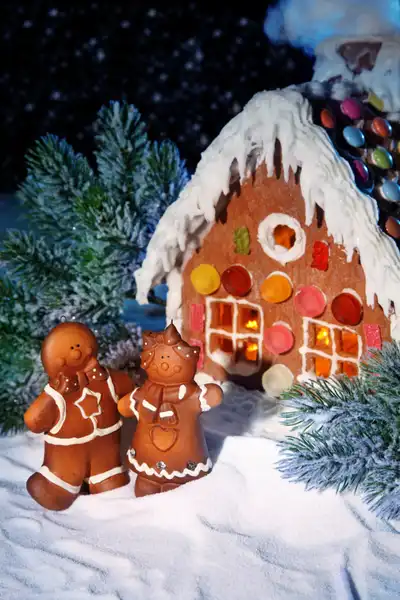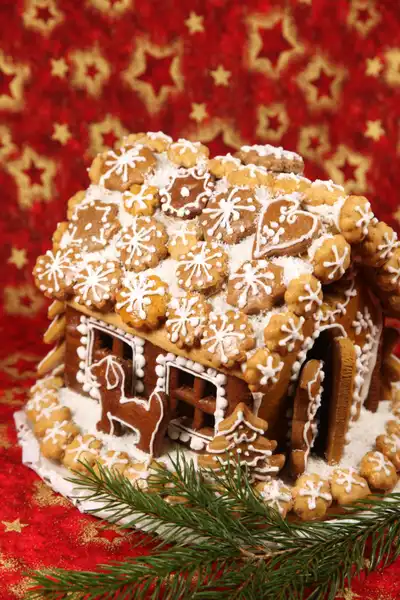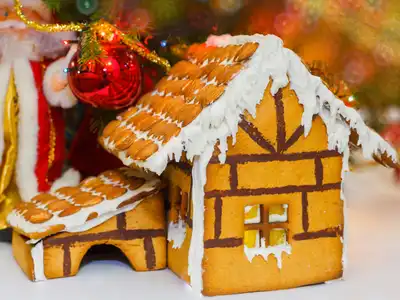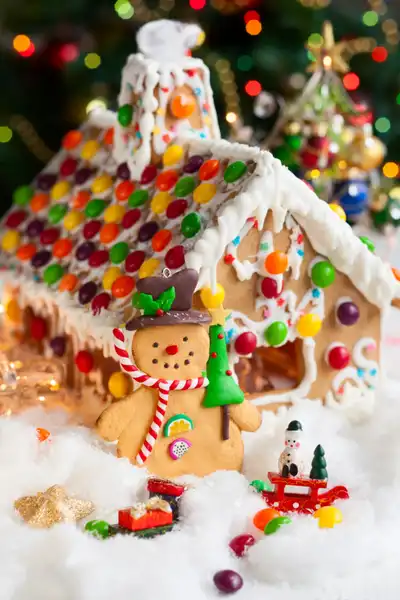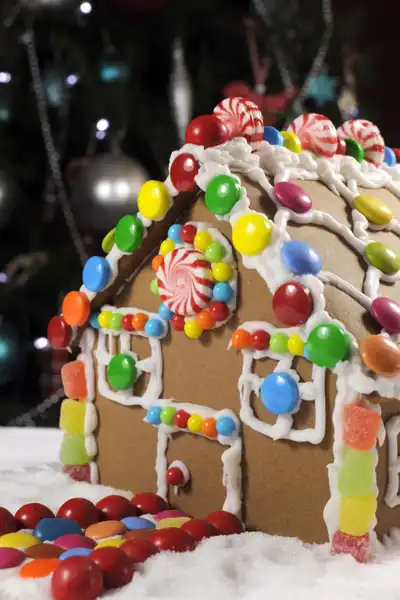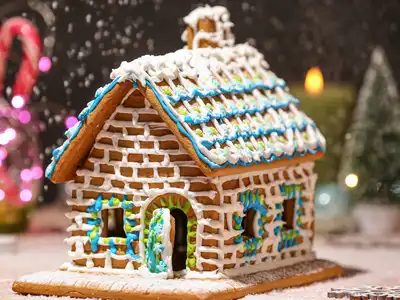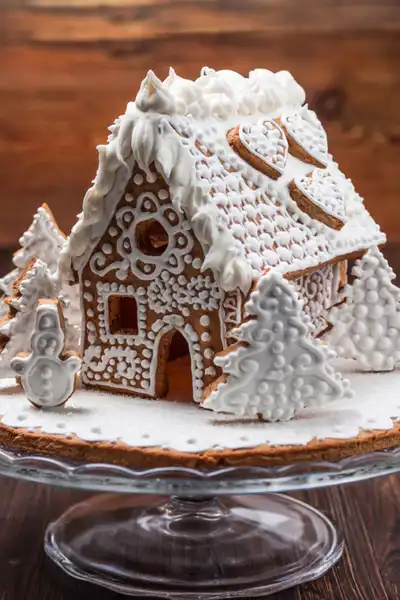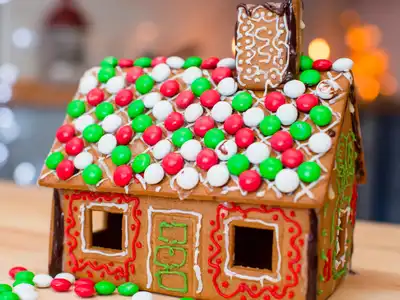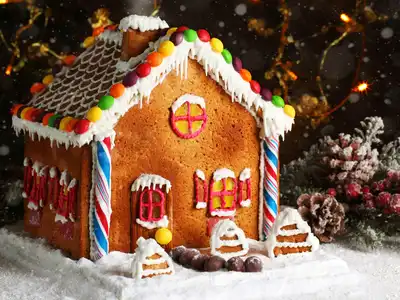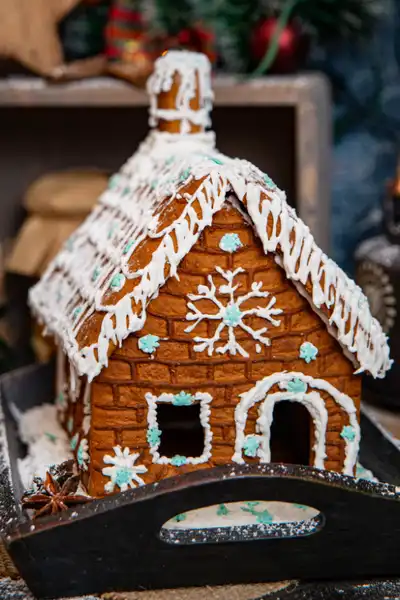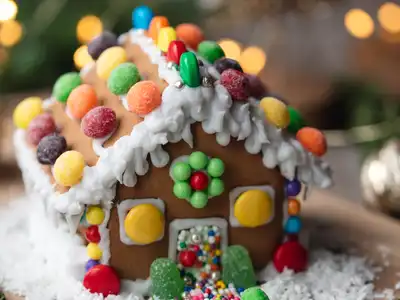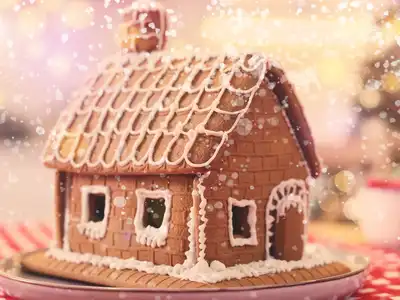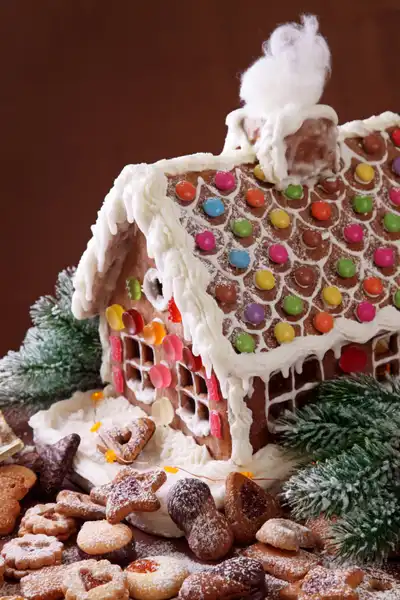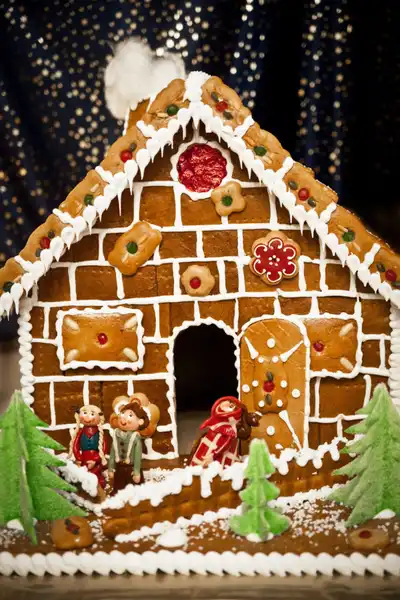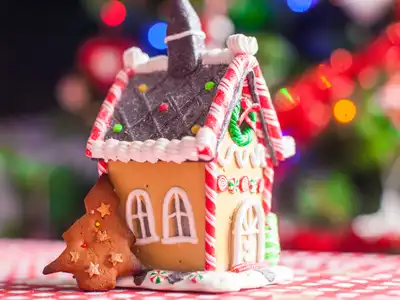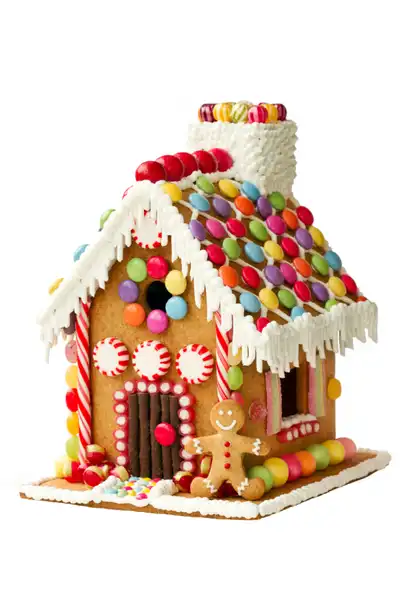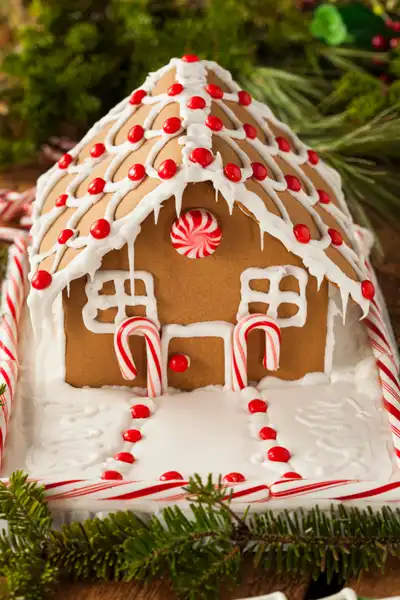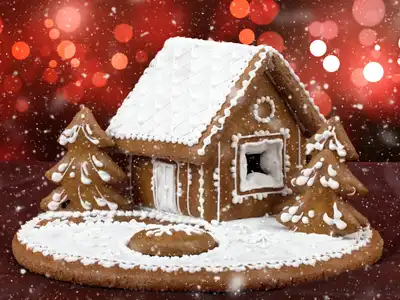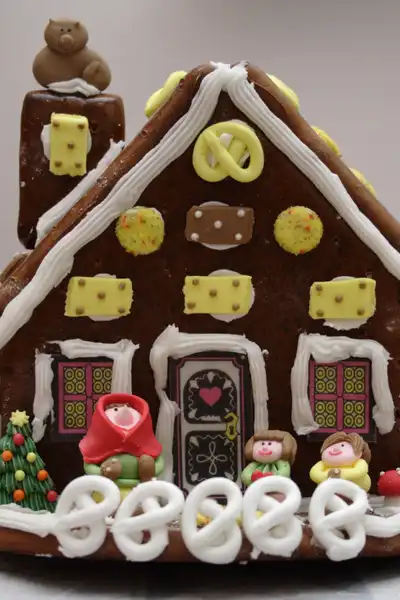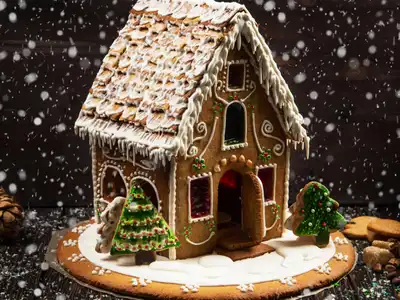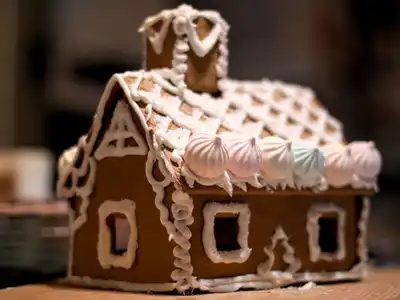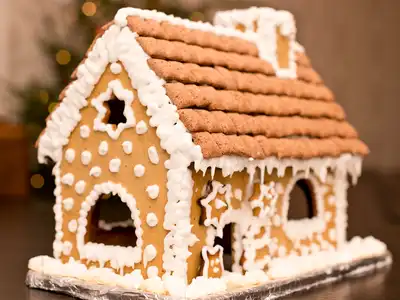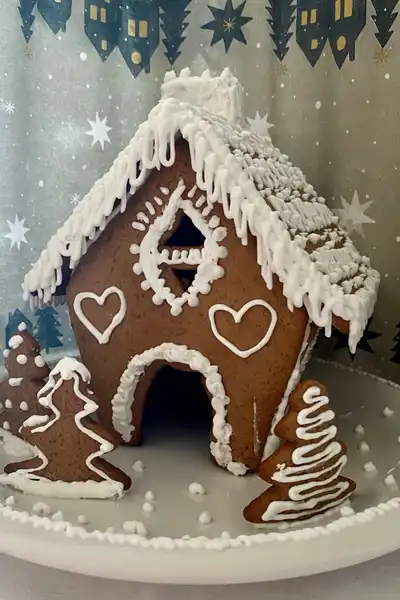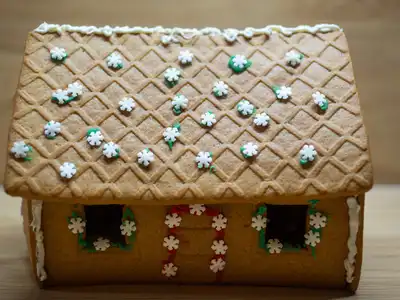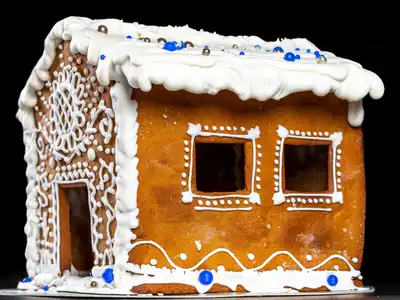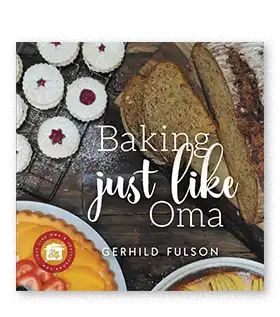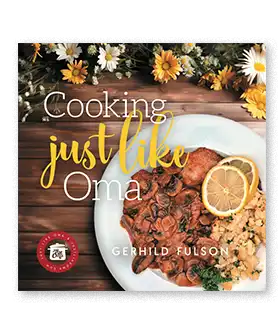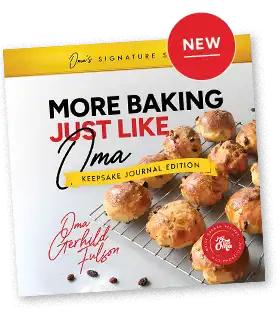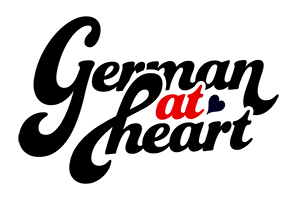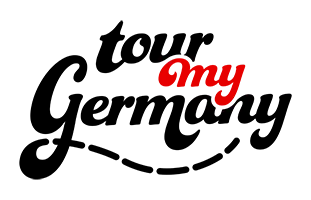Spice up your inbox with FREE German recipes and an exclusive free recipe ebook!
Save up to 50% on all digital items with our Last Minute Christmas Sale on now!
Spice up your inbox with FREE German recipes and an exclusive free recipe ebook!
- Home
- German Christmas Food Recipes
- German Gingerbread House
German Gingerbread House Recipe: Traditional Lebkuchen

by: Gerhild Fulson / Oma Gerhild shares German recipes rooted in family tradition.
Gingerbread houses aren't just for Christmas anymore! This year, why not start a new tradition by crafting a charming Easter gingerbread house?
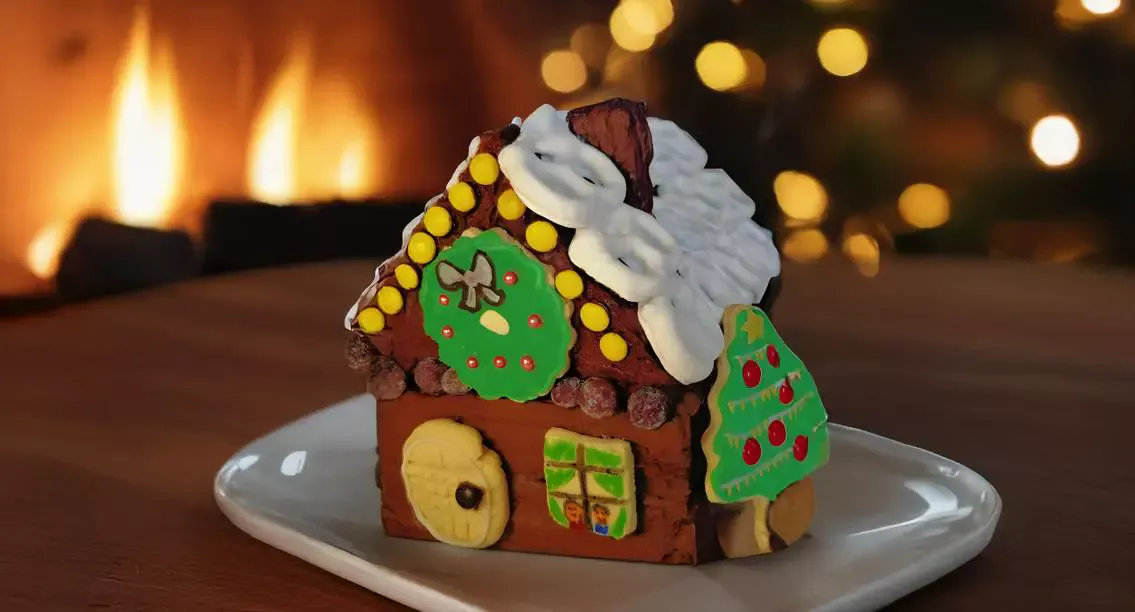
Finding an easy German gingerbread house recipe wasn't easy when I started looking for one many decades ago. I don't recall my Mutti making these for us, but I wanted to make them for our boys.
I had received an old German cookbook from Mutti, and lo and behold, there it was: Einfaches Pfefferkuchenhaus (easy gingerbread house).
What You'll Find Below
- The History of Gingerbread
- Easy Gingerbread House Ideas
- How to Construct a Gingerbread House
- Recipe to Make Your Own Gingerbread House
And so began a new tradition in our house. For some Christmases, it was just me making it as a surprise for the boys. Other times, it was totally their design and decoration. We tried different recipes. We built forts, castles, and even Noah's ark. Sadly, we didn't take any photos, except one.
This year, Lydia helped me re-create that first original German gingerbread recipe because, as I recalled, it really was simple. No fancy house-building skills required.
The pfefferkuchenhaus, also called lebkuchenhaus, has its roots in German folklore, popularized by the story of Hänsel und Gretel by the Brothers Grimm.
The tradition of having these gingerbread homes has been passed down through generations. Modern ones often use pre-made kits, but making one from scratch is so much fun because a gingerbread house and Christmas are a natural fit for family together-time.
The History of Gingerbread
Gingerbread dates back over a thousand years. Its earliest versions appeared in ancient Greece and Egypt. However, gingerbread, as we now know it, took shape in Europe during the Middle Ages, when spices like ginger, cinnamon, and cloves started arriving from the East.
Ginger, prized not only for its warm, aromatic flavor but also for its medicinal properties, became a key ingredient in preserving bread and cakes. The term 'gingerbread' originally referred to any preserved sweet made with honey and spices, rather than the baked goods we associate with the name today.
By the 13th century, lebkuchen — Germany’s version of gingerbread — was being baked in monasteries. Monks combined honey, spices, and flour to create hearty cakes, often shaped into religious symbols or adorned with intricate patterns.
Lebkuchen was particularly associated with Nuremberg in Bavaria, which became known as the "gingerbread capital" due to its central location along spice trade routes.
German lebkuchen was closely linked to holidays and festivals. During the Christmas season, it was typically sold at Weihnachtsmarkte (Christmas markets) where it was decorated with icing, nuts, or chocolate and packaged in festive shapes like hearts and stars.
In 1812, the fairy tale of the Brothers Grimm, Hänsel und Gretel, was published. The story of two children discovering a witch’s edible house in the forest captured children's imaginations. It wasn't long before the idea of creating fancy candy houses became a holiday activity.
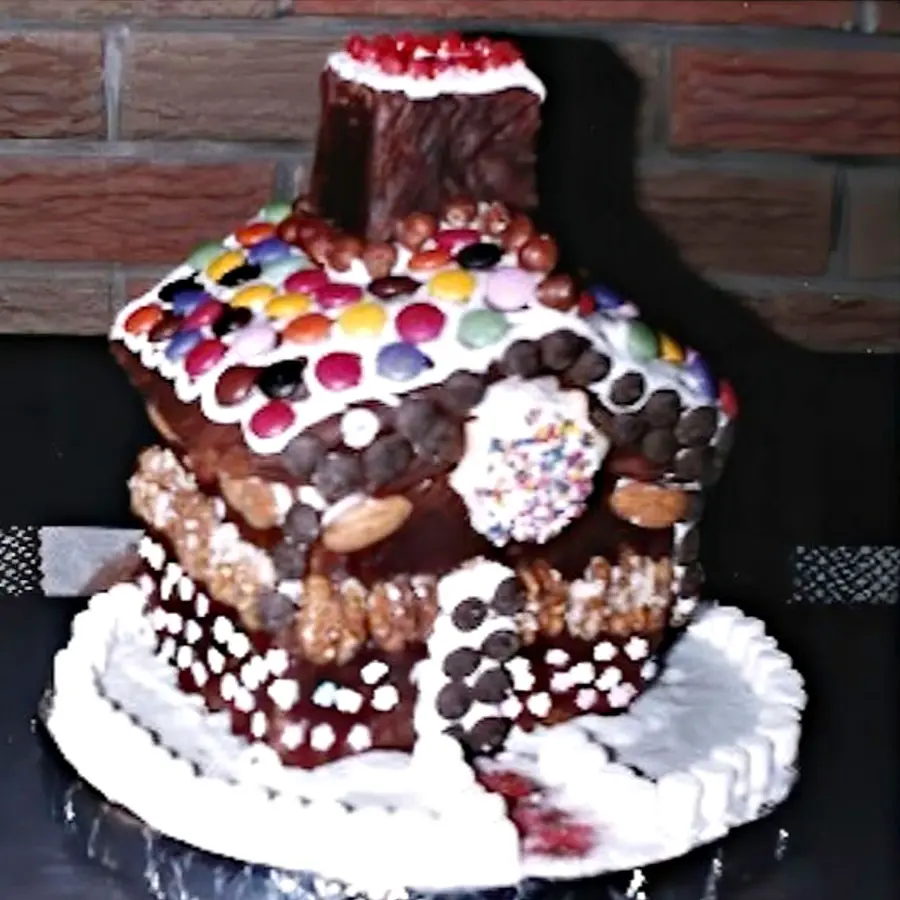 Here's that first German gingerbread house I made over 50 years ago. No googling for ideas. Just followed that old recipe and this happened :)
Here's that first German gingerbread house I made over 50 years ago. No googling for ideas. Just followed that old recipe and this happened :)While Germany is widely recognized for its lebkuchen, gingerbread traditions have spread across the world. In Sweden, gingerbread cookies, pepparkakor, are a Christmas staple. In the UK, gingerbread biscuits are shaped into people and animals. Meanwhile, in the United States, the idea of a lavishly decorated Christmas gingerbread house has become a cherished part of the holiday season for many people.
So, when you’re making a gingerbread house or biting into a piece of lebkuchen, you’re part of a rich culinary history that spans centuries—a little taste of German heritage with every bite.
Easy Gingerbread House Ideas
Open up the curated list below to see many ideas of how to decorate your homemade pfefferkuchenhaus. There are so many ways to make yours unique.
Curated Gingerbread House Ideas:
How to Construct a Gingerbread House
While most German gingerbread house recipes use a template and pieces of cut-out gingerbread to build the house, this recipe uses a cake itself as the house. Just a bit of cutting it into pieces, and it is almost self-supporting. It only needs decorating, and it's ready to enjoy ... either to look at or to nibble on.
Make the gingerbread cake as given in the recipe card below. It will be baked in a 9×13 inch (23×33 cm) baking pan. Once it is baked and cooled, cut it so that you get two base pieces and two roof pieces (one will also be cut into the attic filler).

Take one of the roof pieces and cut a strip that will become the attic filler piece. This also makes the one roof piece a bit narrower, allowing the roof to fit properly.
Trim a bit off the roof pieces that will be 'glued' with icing together to become the chimney.
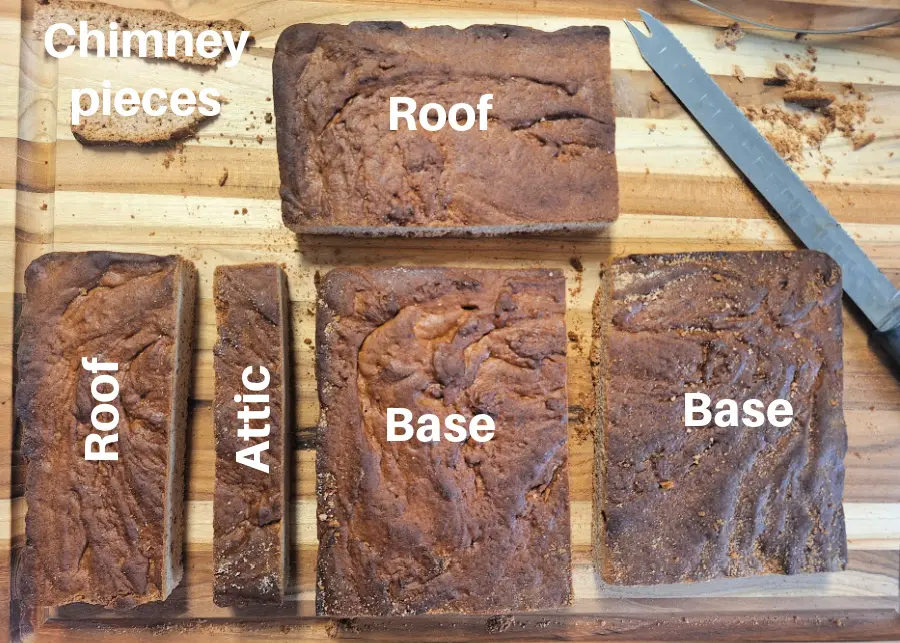
Here's the template to use, but you can sort of eye-ball it as well.
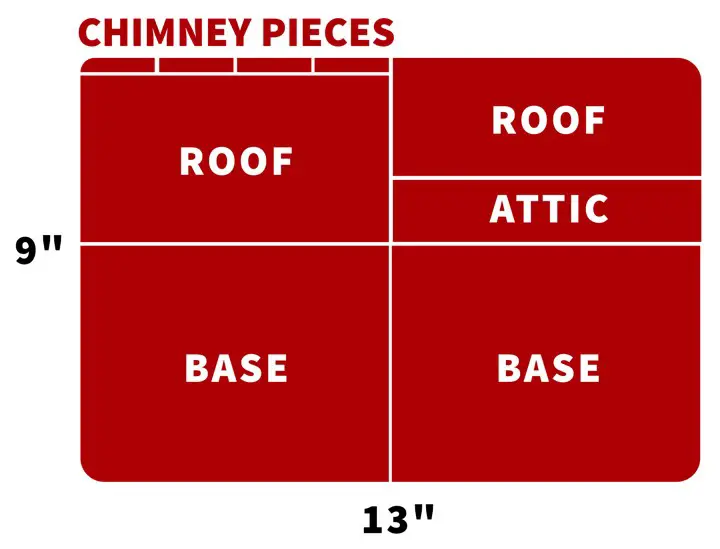
Test build the house to see how it fits together. The roof pieces should balance properly and the building should stand without any further adjustments.
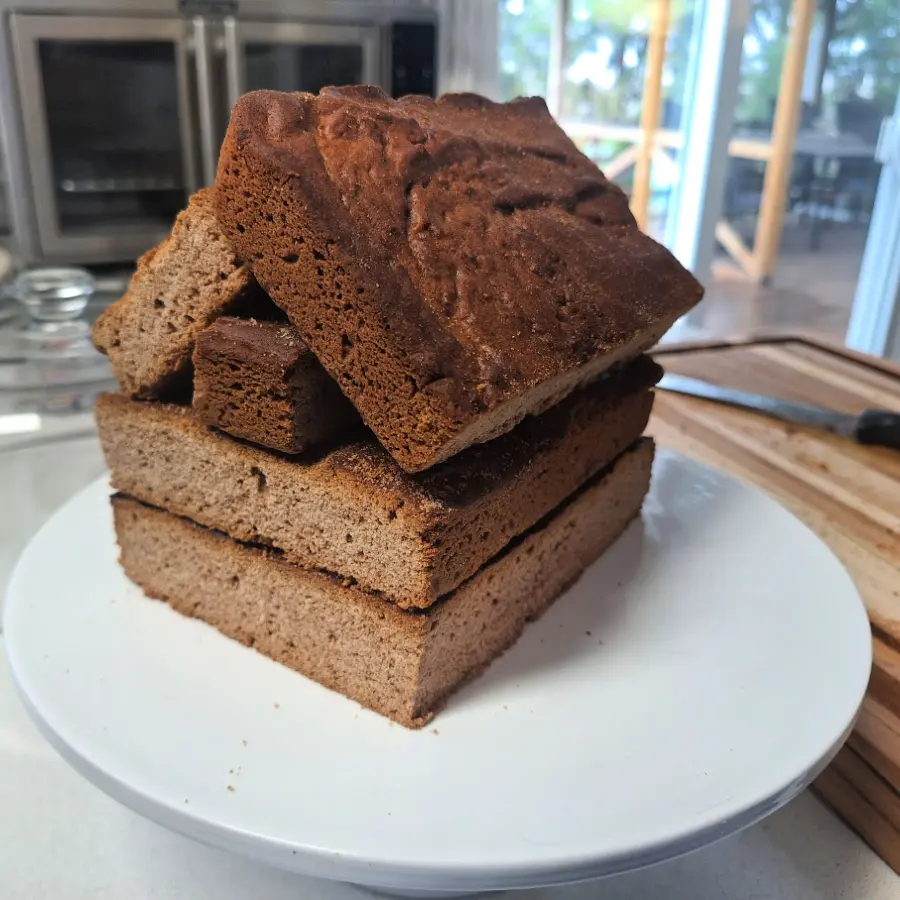
If the base has risen enough, you can cut it into extra layers if you wish.
Make a thick sugar glaze (recipe in the Notes/Hints of the recipe card). Using gel colors, mix a drop of blue, red, orange, and yellow to get a chocolate brown color.

Pipe the thick sugar glaze around the outside perimeter of one base. Spread the jam inside as a filling for the 'cake'. This will also help the lebkuchen remain moist.
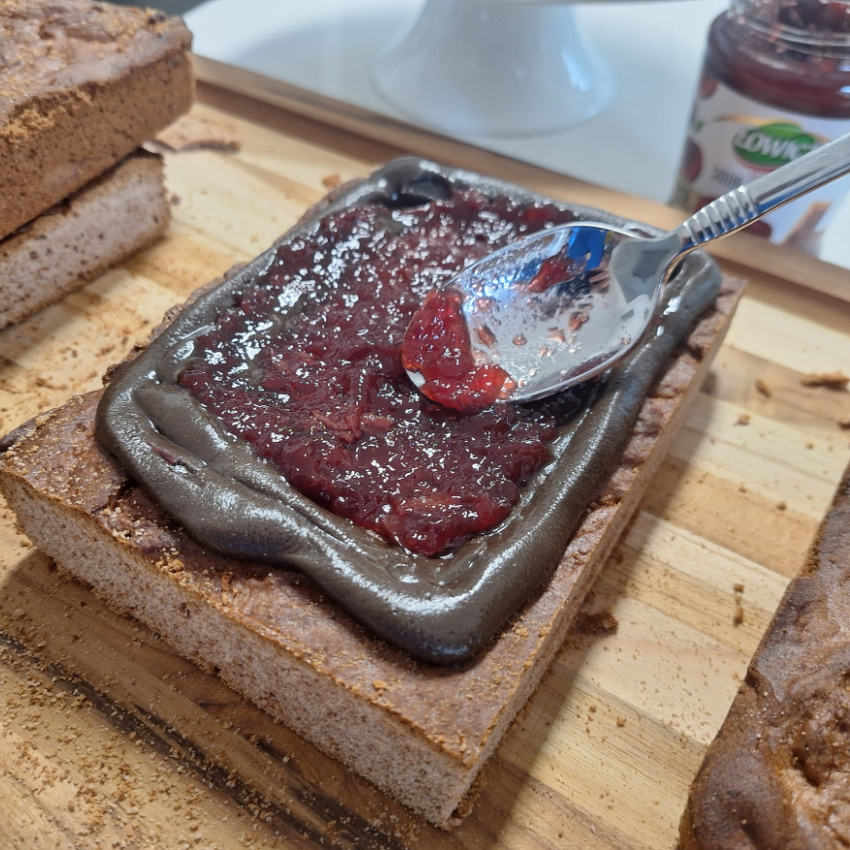
Stack the next base and the attic filler piece in the middle, 'buttering' the pieces together with the brown royal icing.
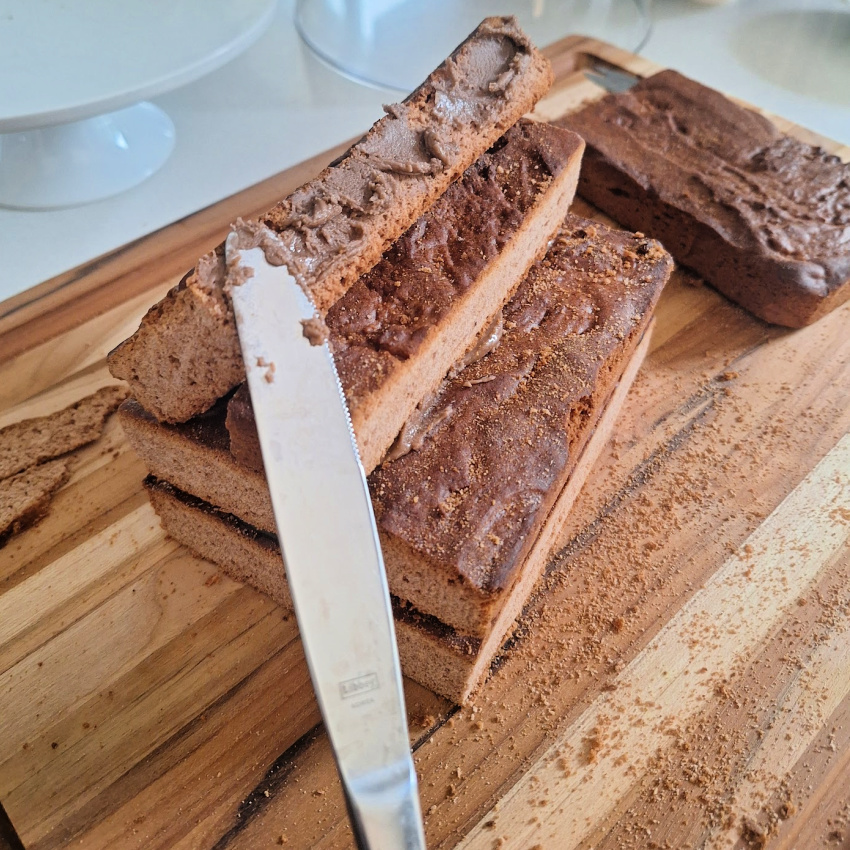
Add the other roof piece and the pieces of glued 'roof' and fill any obvious holes with more sugar glaze.
Make the chocolate glaze (recipe in the Notes/Hints of the recipe card) and brush over the whole gingerbread house to encase it in chocolate and keep the cake from drying out.
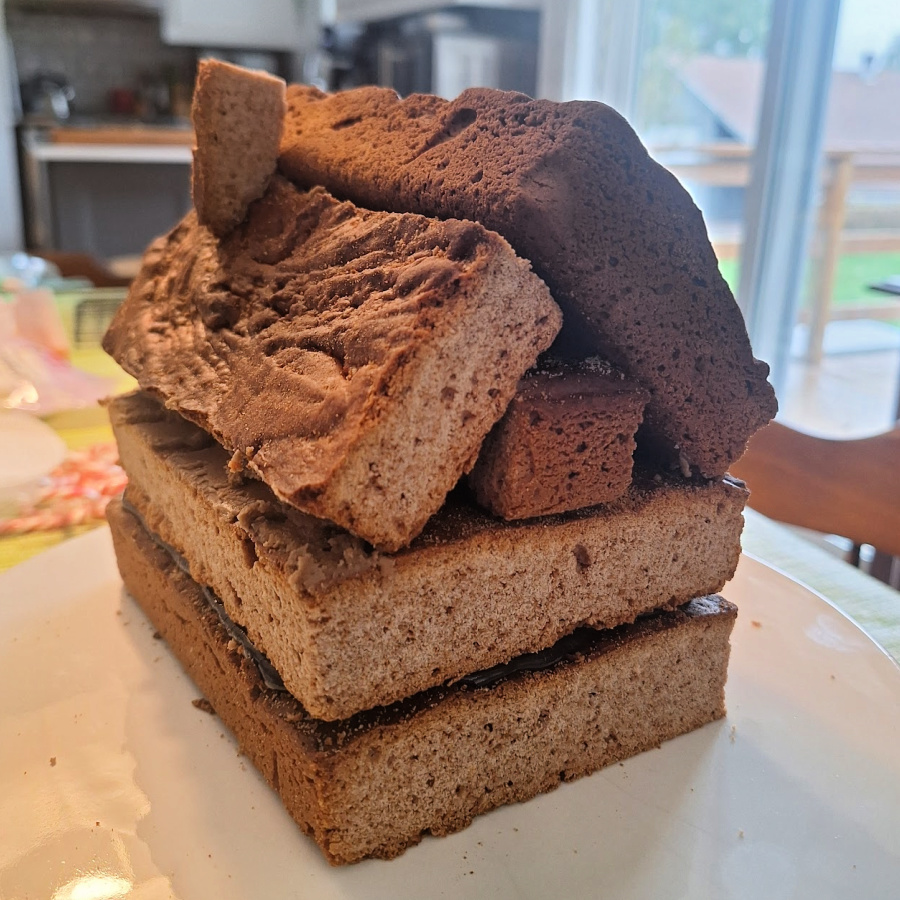
Once the chocolate has dried, you can decorate as desired. Here, Lydia used the thick sugar glaze to pipe the roof tiles and then as glue for the green Christmas tree candies to resemble holly leaves and as glue for the red candies to resemble holly berries.
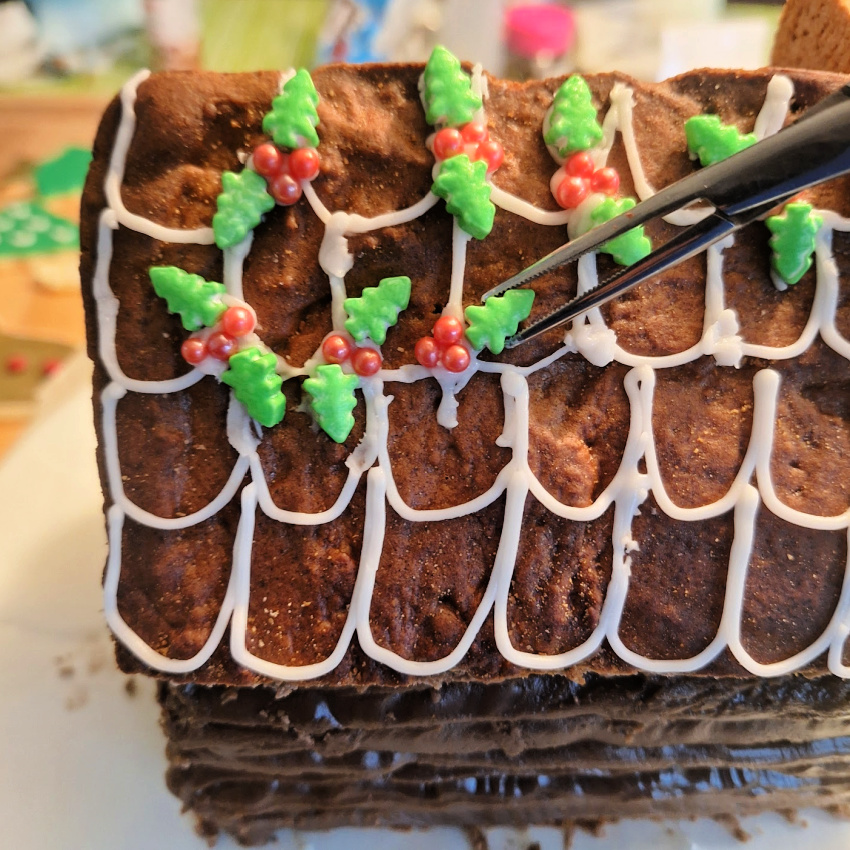
For the gingerbread house above, Lydia didn't cover (forgot to cover!) with chocolate first, because she was going to turn this into a log cabin and would cover the sides and front with the sugar glaze.
She piped the thicker brown sugar glaze along the walls, and white sugar glaze was piped and filled to become a window.
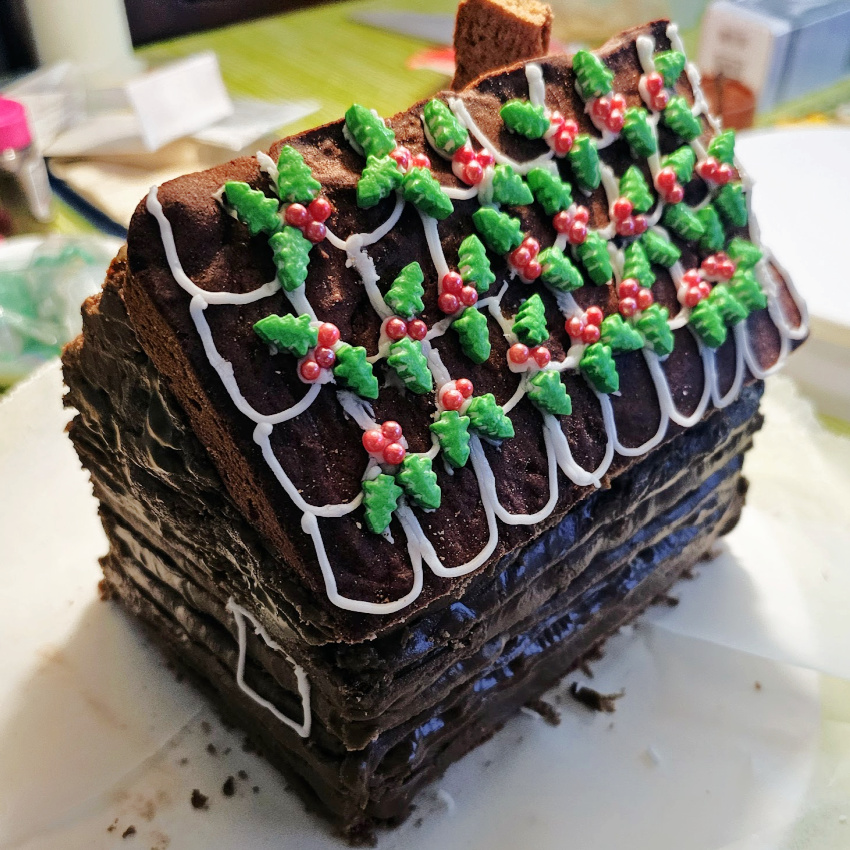
Decorated cookies became a door and a wreath over the door. Two candy canes became a sweet heart on one side and once the window glaze was dry, a Christmas tree was painted inside the window with edible markers.
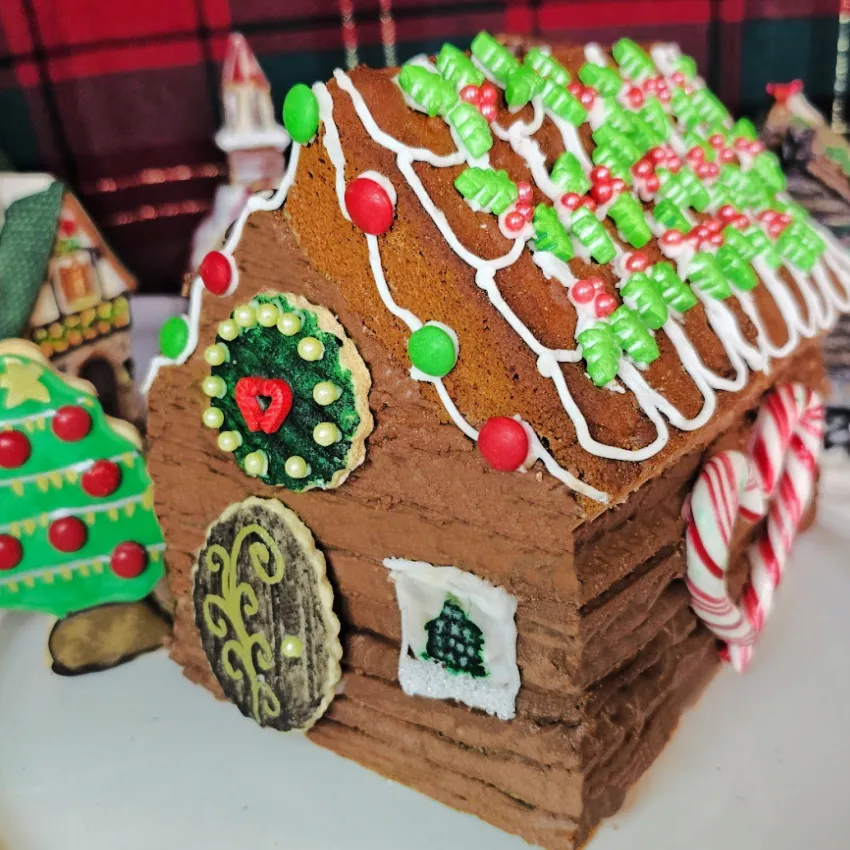
A Christmas tree cookie, decked out with red baubles and strands of lights, stands beside the finished lebkuchen haus.
After Lydia finished decorating the front and one side, I tackled the back and the other side. I, too, added a cookie door and wreath, but chose to add a cookie window that I colored using edible markers.
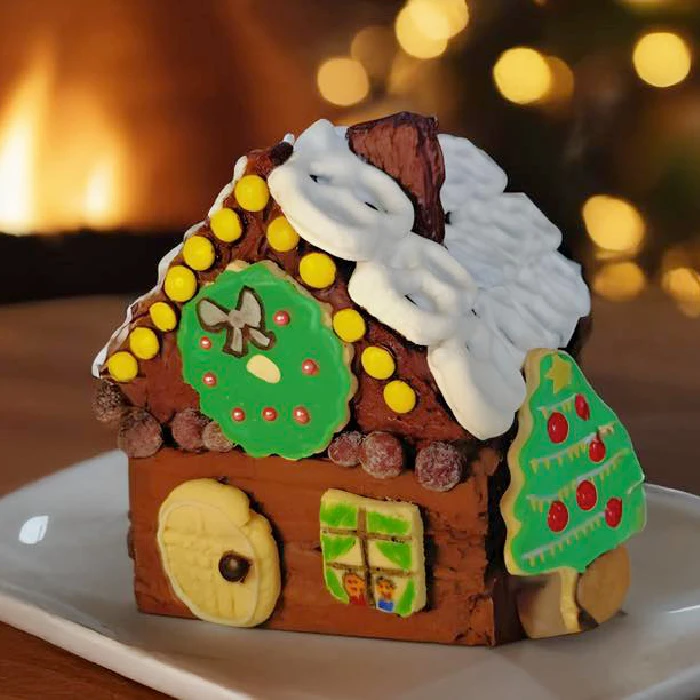
However, I first painted the attic and roof with chocolate glaze and used that chocolate glaze to attach the yogurt-covered pretzels as roof tiles and the M&M's and candies to the front.
Lydia and I certainly had a fun afternoon, re-creating that first gingerbread house that I had made over 50 years ago.
Ready to make your own German Gingerbread House?
German Gingerbread House Recipe: Traditional Lebkuchen
Whether you're building your first house or continuing a cherished tradition, this easy recipe for a traditional German gingerbread house makes it simple and fun to craft something beautiful and delicious for the holidays. The base is a honey cake, which makes it both easy to assemble and irresistibly delicious. No complicated construction skills are required.
Prep Time:
40 minutes
Bake Time:
50 minutes
Cooling & Decorating Time:
2 hours
Total Time:
3 hours 30 minutes
Servings:
Makes 12 - 16 servings
Ingredients:
- 1 cup (350 g) honey
- ⅓ cup (80 g) granulated sugar
- ½ cup (100 g) butter
- ½ cup (125 ml) milk
- 2 eggs
- 1 tbsp (6 g) cocoa powder
- 1 tbsp (1 packet) lebkuchen spice mix (see hints below)
- 1 tbsp (12.5 g) granulated sugar
- 4 cups (500 g) all-purpose flour
- 1 tbsp (12 g) baking powder
- chocolate or sugar glaze (see hints below)
- ¼ cup (80 g) cherry jam (optional)
- sugar glaze (see hints below)
- candies, cookies, and/or sprinkles for decorating
Instructions:
- Preheat oven to 360°F (180°C). Grease a 9 × 13 (23 × 33 cm) baking pan and set aside.
- In a small saucepan, heat the honey, sugar, and butter together over medium heat, stirring constantly, until the mixture is smooth and well combined. Remove from heat and set aside to cool slightly.
- In a large mixing bowl, whisk together the milk, eggs, cocoa powder, gingerbread spice, and 1 tablespoon of sugar until frothy.
- Add the cooled honey mixture and stir until well blended.
- Stir in the sifted flour and baking powder until the dough is well mixed.
- Spoon the stiff dough into the prepared baking pan. Bake for 40 to 50 minutes, or until a toothpick inserted in the center comes out clean. Be careful not to overbake.
- Let the cake cook in the pan for about 15 minutes before turning out onto a cooling rack. Cool completely before proceeding to build your gingerbread house.
Assembly:
- Once the cake is fully cooled, cut into sections as shown in the post above.
- On the base layer, pipe a thick bead of sugar glaze around the upper edge. Spread the jam within those borders.
- Place the next layer on top. Position the roof pieces in place, with the spare piece in the ‘attic’ space.
- Either cover the entire house with a thin coating of sugar glaze or chocolate glaze (my favorite).
- Now it's time to decorate the gingerbread house as desired. You can do so before the glaze hardens, or use the liquid glaze (sugar or chocolate) as the “glue”. Use the thicker sugar glaze to draw roof tiles or outline windows, etc.
- As long as the house is completely covered with the glaze, the gingerbread house can last 2 to 3 weeks at room temperature if it is kept cool and dry. Cover it loosely with plastic wrap or a cake dome to shield it from dust and pests to keep it edible. If the house is just for show, it can be kept longer.
- Once this cake is cut into, use plastic wrap or foil to cover any exposed parts of the cake to prevent it from drying out.
- Alternatively, choose to disassemble the cake and cut the cake into serving pieces. Place these in an airtight container and cover tightly. This can be stored in the fridge for up to 7 days. Heating the individual pieces in the microwave for a few seconds will restore the spices and moisture. Serve with whipped cream on the side. Set aside the gingerbread house decorations, like the cookies and candies, to serve separately.
Notes/Hints:
- To make your own lebkuchen spice mix, combine 2 tablespoons (18 g) ground cinnamon, 2 teaspoons (4 g) ground cloves, and ½ tsp (1 g) each of ground mace, coriander, cardamom, ginger, and nutmeg. Makes 3½ tablespoons.
- Pumpkin pie spice can be used 1 to 1 for the lebkuchen spice mix. It's not identical, but it makes a delicious gingerbread as well.
- To make a chocolate glaze, in a microwave-safe bowl, melt 1 cup (170 g) of semi-sweet chocolate chips in 20–30 second intervals, stirring each time, until smooth. Stir in 1 teaspoon of vegetable oil. Use while it is warm, as it will harden as it cools. Coat the whole house and use it to attach candies and cookies.
- To make a sugar glaze (an alternate royal icing), in a large bowl, beat 2½ cups (312.5 g) icing sugar, 1½ tbsp (22.5 ml) light corn syrup, 1 tsp (5 ml) clear flavoring extract, and 2 tbsp (30 ml) milk. Slowly add more milk (½ teaspoon at a time) until you have the consistency needed. For flavoring, use a clear vanilla, peppermint, or almond extract. Add food color if desired. Use thicker icing for outlining and thinner to brush on the walls and roof.
* * * * *
Unless otherwise noted recipe, images and content © Just like Oma | www.quick-german-recipes.com
Updated on October 13, 2025
Comments? Questions?
You can leave a comment about this recipe or ask a question...
Pop right over to my private Facebook group, the Kaffeeklatschers. You'll find thousands of German foodies, all eager to help and to talk about all things German, especially these yummy foods.
Meet with us around Oma's virtual table, pull up a chair, grab a coffee and a piece of Apfelstrudel, and enjoy the visit.
Recent Articles
-
Pork Schnitzel Sliders (Mini German Sandwiches with a Crunch)
Dec 17, 25 11:05 AM
Crispy pork schnitzel sliders recipe. Bite-sized German sandwiches perfect for parties, game day, or Oktoberfest. -
Oma's German Rhubarb Cake With Streusel (Rhabarberkuchen mit Streusel)
Dec 13, 25 11:14 PM
This German Rhubarb Cake (Rhabarberkuchen mit Streusel) tastes just like Mutti’s … sweet, tart, buttery, and baked with love. -
German Plum Cake Recipe (Streusel Pflaumenkuchen / Zwetschgenkuchen)
Dec 13, 25 09:36 PM
Looking for a real German plum cake? This Zwetschgenkuchen brings tender plums, buttery crumble, and simple homemade comfort in every bite.
Words to the Wise
"The godly are showered with blessings; the words of the wicked conceal violent intentions."
Proverbs 10:6 (NLT)
